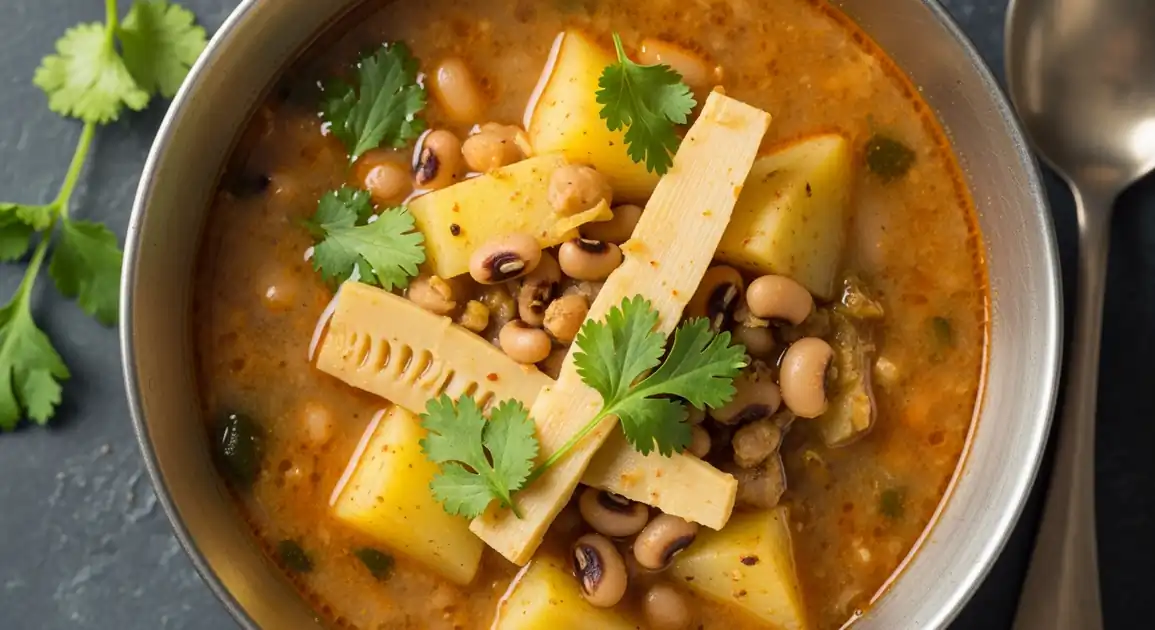Aloo Tama (Potato and Fermented Bamboo Shoot Soup)
आलु तामा

Description
In Kathmandu, Aloo Tama is a widely available and cherished dish. You can find excellent versions in restaurants specializing in Newari cuisine (particularly in the old towns of Patan, Bhaktapur, Kirtipur, and Kathmandu itself), Thakali restaurants, and numerous local eateries throughout the valley. It's a must-try for experiencing authentic Nepali flavours.
Dietary Information
Serving information
Serving style
Served hot in a bowl, almost always intended to be eaten with steamed rice. Garnished with fresh coriander.
Quick facts
Lunch service typically 11 AM - 3 PM, Dinner 6 PM - 10 PM. Local eateries might have more flexible hours.
Safety Tips
What to Look For
-
Served steaming hot
Ensures the soup is cooked thoroughly and held at a safe temperature, minimizing risks.
-
Reputable restaurant or eatery
Choose places known for good hygiene and quality Nepali food for a safer experience.
-
Fresh appearance and aroma
While Tama has a pungent smell, the overall dish should smell appetizingly tangy and spicy, not spoiled or overly sour. Ingredients should look fresh.
-
Clear broth (unless intentionally thickened)
A clear, appetizing broth is typical. Excessive cloudiness (not from potato starch) might be less appealing but isn't necessarily unsafe.
What to avoid
-
Soup served lukewarm or cold
Unsafe temperature zone. Ask for it to be reheated properly or choose something else.
-
Visibly unclean serving bowls or utensils
Indicates poor hygiene standards.
-
Strong 'off' smell beyond the normal tama pungency
Could indicate spoilage of ingredients. Do not consume if it smells bad.
-
Eateries with obviously poor hygiene standards
Avoid places that look dirty or handle food improperly.
Price information
Price range
Budget tips
- Local 'khaja ghars' in non-tourist areas offer the best prices (120-250 NPR).
- Restaurants in Thamel or upscale areas will charge more (250-450 NPR).
- Ordering it as part of a Nepali Khana Set is often economical.
- Newari eateries in Patan or Bhaktapur can offer great taste at reasonable prices.
Value indicators
- Authentic tangy flavour specific to well-prepared tama.
- Served piping hot.
- Good balance of potato, tama, and bodi (if included).
- Recommended by local patrons.
Where to Find This Dish
Thamel
Many restaurants catering to tourists offer Aloo Tama, quality varies but convenient.
Throughout Thamel's lanes
Lunch, Dinner
Patan / Lalitpur
Known for its strong Newari heritage, find authentic versions in local eateries and Newari restaurants.
Patan Durbar Square vicinity, Inner lanes of Patan
Lunch, Dinner
Bhaktapur
Another Newari stronghold with excellent traditional food options, including Aloo Tama.
Bhaktapur Durbar Square area, Local restaurants
Lunch, Dinner
Boudha / Jorpati
Areas with many local eateries serving everyday Nepali food.
Around Boudhanath Stupa, Local neighbourhoods
Lunch, Dinner
Vendor Tips
- Venture into Patan or Bhaktapur for potentially more authentic Newari-style Aloo Tama.
- Look for Thakali restaurants (like Thakali Bhanchha Ghar) for well-regarded versions often served with elaborate thalis.
- Confirm spice level when ordering if sensitive.
- Observe where locals are eating for clues on good spots.
How to Order
Regional Variations
-
Newari Style Aloo Tama
(नेवारी आलु तामा)
May have slight variations in spice blend or preparation technique specific to Newar traditions, often robustly flavoured.
-
Thakali Style Aloo Tama
(थकाली आलु तामा)
Often served as part of a refined Thakali thali, potentially with slight differences in spices or consistency compared to home-style versions.
Cultural context
History
Aloo Tama is deeply rooted in Nepali culinary traditions, particularly associated with the Newar community of the Kathmandu Valley but enjoyed nationwide. The use of fermented bamboo shoots (tama) stems from traditional methods of preserving bamboo, a readily available resource, making its unique flavour accessible year-round. Potatoes, though introduced later to Nepal, integrated seamlessly into this dish, creating the staple it is today.
Local significance
In Kathmandu Valley, Aloo Tama is especially significant within Newar culture but enjoyed by all. It represents a core flavour profile in Nepali cuisine – the skillful use of fermentation to create unique tastes.
Eating customs
- Eaten with rice.
- Considered a 'tarkari' (vegetable dish/curry) or 'jhol' (soup/broth) component of the main meal.
- Shared as part of a communal dining experience.